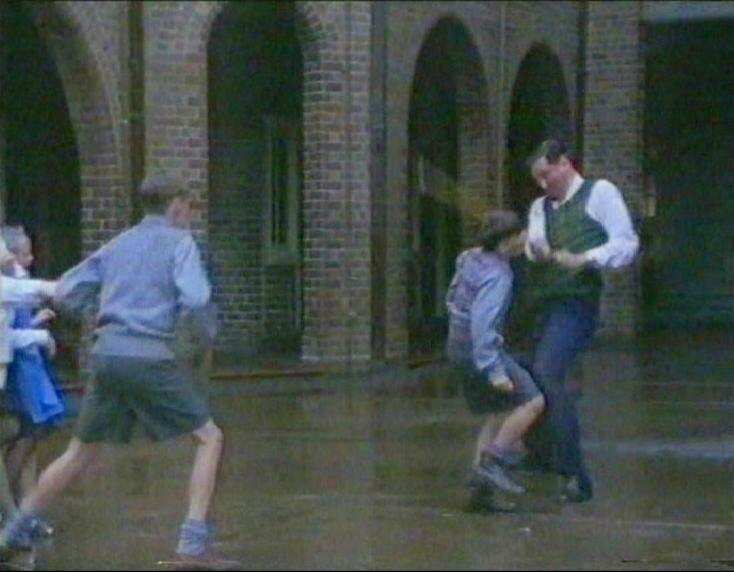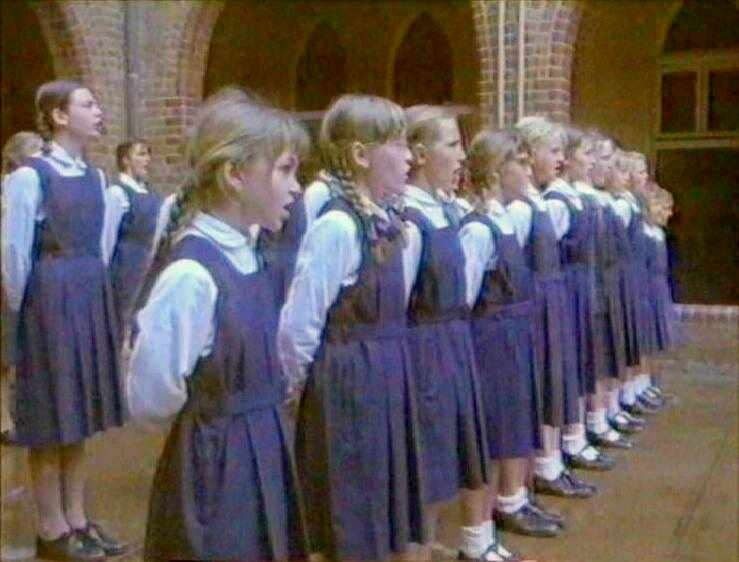
The Leaving of Liverpool (England, 1992)

Figure 1.-- This is a TV production about a Liverpool church children's home. I haven't seen the film. I don't think it is a documentary, but it appears to be fact based. To give the children a "better" life, the church decided to export the kids to Australia, Canada, and New Zealand. I think the Christian Brothers were involved. They were a well known Irish order, deeply involved with Irish education.
|
This is a TV production about a Liverpool church children's home. I haven't seen the film. I don't think it is a documentary, but it appears to be fact based. Liverpool of course is an English city, but it has a substantial Irish population and many of the children involved were Irish. It was a mixed home in terms of gender and religion. This film was set around 1951. To give the children a "better" life, the church decided to export the kids to Australia, Canada, and New Zealand. I think the Christian Brothers were involved. They were a well known Irish order, deeply involved with Irish education. I think the early 60s, they ceased
to have anything to do with irish state education. They are active in Catholic schools in many countries, including America, Australia, and New Zealand. The majority of these children (some who were only supposed to be in tempory care,) where sent to the Dominions irrespective of parental permission.
Filmology
This was a BBC production dramatising how youngsters were despatched to a 'better life' in Australia in the years immediately following World War II. The “The Leaving of Liverpool” was one of the most widely watched TV programs in Britain during 1992. It received considerable critical aclaim and was awarded the American Film Institute Award for Most Outstanding Drama and Best Screenplay, TV Week Logie Award for Most Outstanding Mini-Series and the Australian Humanitarian Award. Yhe film was produced by Steve Knapman.
Cast
The cast includied Bill Hunter, John Hargreaves, Martin Jacobs and Frances Barber. The children gave especially good performances, but I'm unfamilaer with their names.
Liverpool Home
This is a TV production about a Liverpool church children's home. I haven't seen the film. I don't think it is a documentary, but it appears to be fact based. The children at the home might be orphans or children with an unmarried mother, to which a stigma was attached at the time.
Liverpool
Liverpool of course is an English city, but it has a substantial Irish population and many of the children involved were Irish. It was a mixed home in terms of gender and religion.
Plot
This film was set around 1951. To give the children a "better" life, the church decided to export the kids to Australia, Canada, and New Zealand. The majority of these children (some who were only supposed to be in tempory care,) where sent to the Dominions irrespective of parental permission. The drama focused on some children in a catholic institution and how thay are conned into volunteering to go to Australia. A reader tells us, "I watched this TV film when it was was screened. I think it was a two part film. It concentrated on a group of children sent out to Australia and the Cathlic Boarding School they were sent to. One boy was a sensitive lad who died from the harsh treatment at this orphanage. The kids built the place. I think this film opened up the discussion about the abuse that occurred to these children at this orphanage and similar institutions." The film follows of Bert and Lily, two of the English children uprooted from the Liverpool dockside. They were realtively happy there. It is hard to tell just how deprived the children were in Liverpool and how much there situation was actually improved or worsenmed in Australia. The story line here is that Bert and Liverpool liked Liverpool and had a terrible experience in ustralia.
Christian Brothers
I think the Christian Brothers were involved. They were a well known Irish order, deeply involved with Irish education. I think the early 60's, they ceased to have anything to do with irish state education. They are active in Catholic schools in msany countries, including America, Australia, and New Zealand.

Figure 2.-- Here are girls at the orphanage in Liverpool.
|
Australia
Once in Australia life was all too often brutish. The children were certainly put in an environment starkly different from Liverpool. The children were expected
to work for their keep in remote church children's homes, on farms etc. One observer writes, "In Australia the children were used essentially as slave labour. The children were used to build many of the existing buildings, still run by the Christian Brothers. There was widespread abuse of the children, both physical and sexual. Many of these places were built in the middle of nowhere--so it was very difficult for the children to escape. The children were also utilised as slavelabour on farms. Many of theemigrants, having lived in Australia for 50 years , are now attempting to find out about the families they left back in Britain.
Costume
Costume was 'post-war utilitarian.' That is, grey short sleeved pullovers, grey flannel shirts, grey flannel shorts, National Health 'goggle' spectacles, long socks flopping about the ankles, and short back and sides hair.
Impact
"The Leaving of Liverpool" cassued a huge discussion of the practice of sending English children overseas. The discussion and public debate occurred both in England and the countries like Canada and Australia where the children were sent. The now grown children began to speak out and their accounts were widely reproduced in the press where they attracted considerable attention. A British reader writes, "I saw this TV production when it first screened in 1992. It was a two part mini serial and as you say was very difficult to watch. It told a horrific story of abuse by the priests. One of the Liverpool kids is a sensitive boy and he dies under the regime. It was a dramadocumentary.
It opened a debate about the happenings then and lots of lost children were reunited with their parents and family. many of the children thought they were orphans. The film led to an investigation by Australian authorities."
HBC

Navigate the Boys' Historical Clothing Web Site:
[Return to the Main "La-Lh" alphabetical movie page]
[Return to the Main English movie page]
[Introduction]
[Activities]
[Biographies]
[Chronology]
[Clothing styles]
[Countries]
[Theatricals]
[Bibliographies]
[Contributions]
[FAQs]
[Glossaries]
[Satellite sites]
[Tools]
[Boys' Clothing Home]
Created: 8:34 PM 7/26/2004
Last updated: 3:30 AM 9/25/2006




